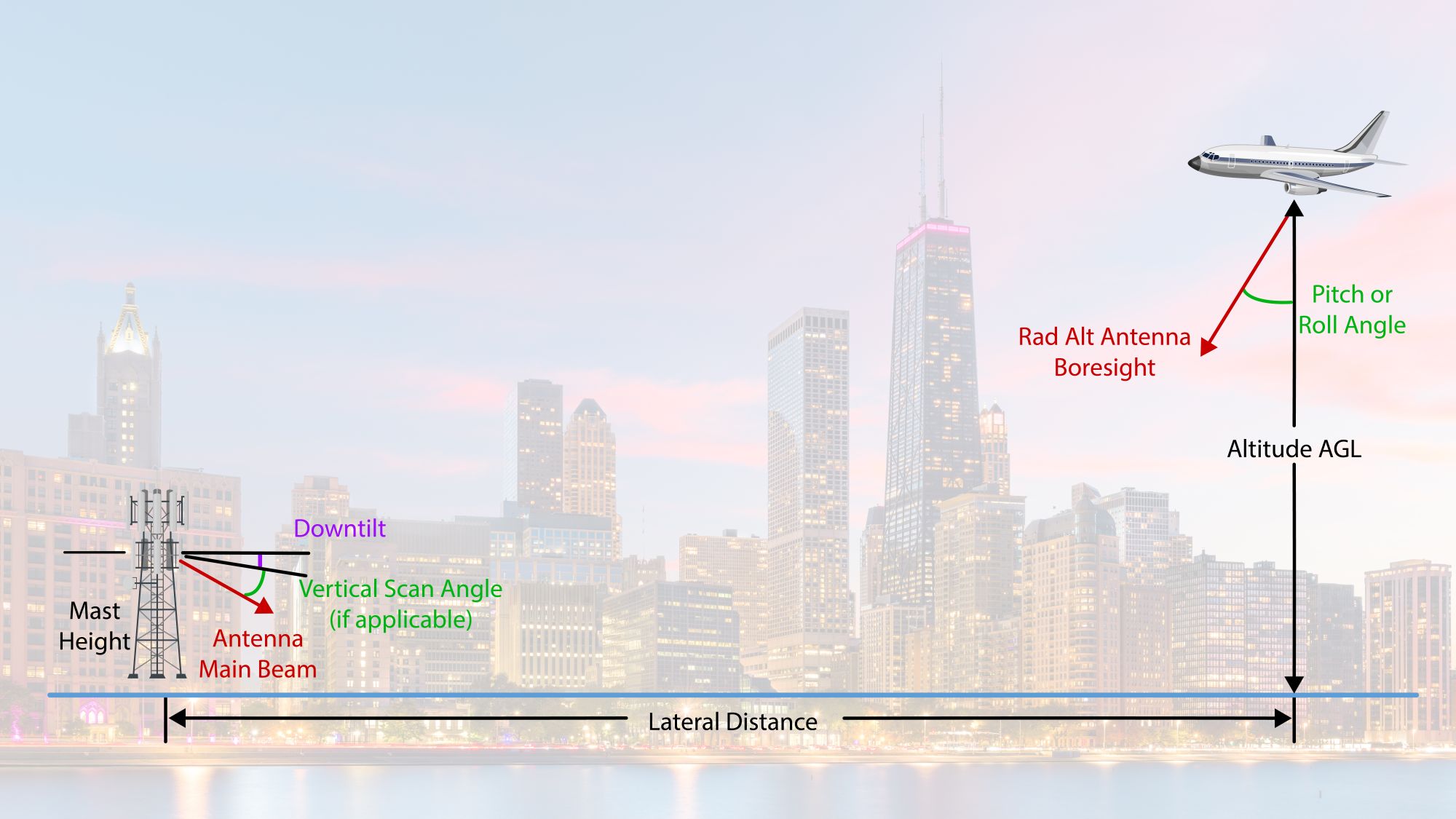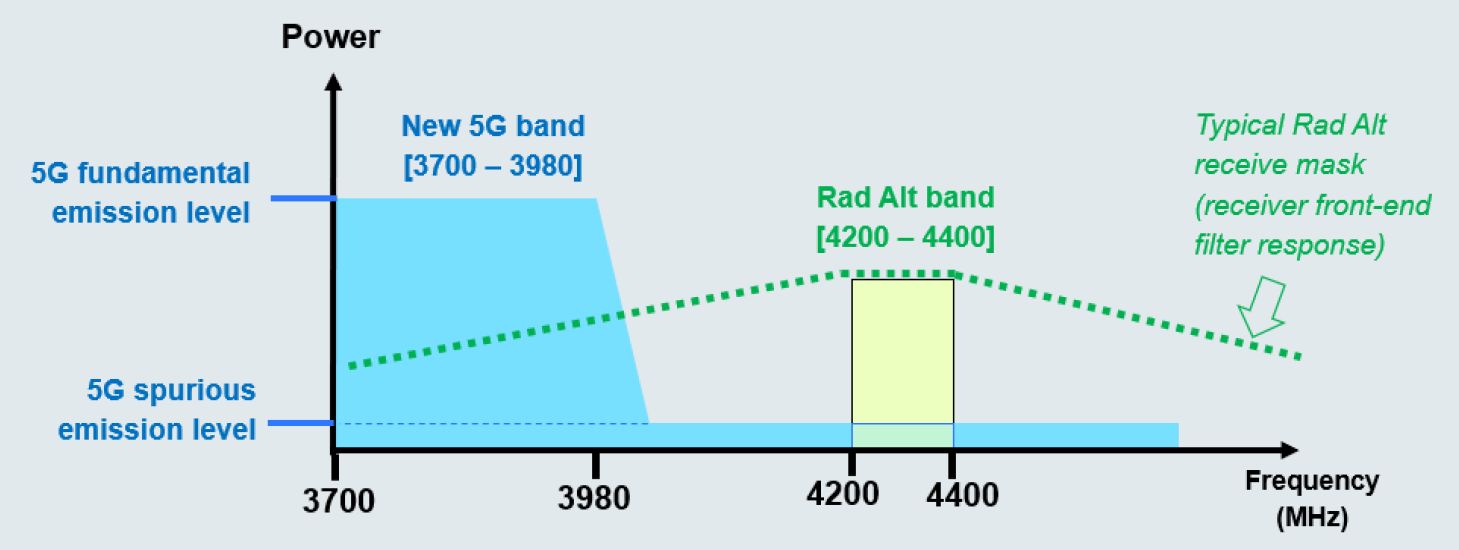The auctioning of the C-band for 5G use has raised concerns in North America that signals could interfere with aircraft altimeter operations. 5GTW asked a filter engineer and a test expert if there’s a problem and how to fix it.
When the FCC auctioned off spectrum in the C-band — 3.7 GHz to 3.98 GHz – winners including Verizon and AT&T spent over $81 billion to acquire portions of that spectrum. The use of the C-band for 5G raised concerns from the aviation industry regarding possible interference with aircraft altimeters.
The issue has caused delays in C-band implementation, now scheduled to begin on January 5, 2022 in the U.S. Furthermore, Canada has restricted the use of the C-band around 26 airports. In response, Verizon and AT&T have reluctantly agreed to reduce transmit power in the C-band, which the aviation industry calls “inadequate.” In another action, the FAA has restricted some flight operations in response to the issue.
While these actions may address the potential problem, they’re hardly a long-term solution, according to Mike Eddy VP, corporate business development & product marketing at Resonant, a manufacturer of RF filters. “Energy from 5G bands can enter the altimeter’s receiver,” said Eddy in an interview with 5G Technology World. “Any transmit system produces spurious noise, which can enter the band of a receiver.”
A 231 page report issued by aeronautics technical group RTCA in November 2020 explains the issue.
The fundamental emissions may lead to blocking interference in the radar altimeter receiver, wherein a strong signal outside of the normal receive bandwidth cannot be sufficiently filtered in the receiver to prevent front-end overload or other effects. The spurious emissions, on the other hand, fall within the normal receive bandwidth of the radar altimeter, and may produce undesirable effects such as desensitization due to reduced signal-to-interference-plus-noise ratio (SINR), or false altitude determination due to the erroneous detection of the interference signal as a radar return.
Figure 1, adapted from the report, provides a visual representation of how signals from a base station may occur at the same time and in proximity to altimeter signals.
Figure 1. Signals from 5G towers that use the C-band will likely occur at the same time as those transmitted from an aircraft altimeter, though at different frequencies. Image adapted from RTCA report “Assessment of C-Band Mobile Telecommunications Interference Impact on Low Range Radar Altimeter Operations, RTCA Paper No. 274-20/PMC-2073.”
“Altimeters have poor filters,” said Eddy. “Under that condition, spurious noise can enter band of receiver. That noise can come from both base stations and handsets. Eddy claims that poor filtering at the receivers raises the potential problem, though he noted that these interference problems are nonexistent in other parts of the world. As you might expect, the telcom industry, through CTIA, contends that claim saying “5G networks using a set of radio waves called ‘C-band spectrum’ operate safely and without causing harmful interference to aviation equipment.”
Figure 2. According to the RTCA report, altimeter receiver filters are inadequate to prevent C-band transmission energy from interfering with the altimeter’s receiver despite a 200-MHz guard band. Image: RTCA report “Assessment of C-Band Mobile Telecommunications Interference Impact on Low Range Radar Altimeter Operations, RTCA Paper No. 274-20/PMC-2073.”
Figure 2, from the report, shows the reason for concern in the aviation industry. Spurious emissions such as harmonics from 5G transmissions could leak into the altimeter’s receiver, potentially preventing it from receiving signals reflected from the ground. The lack of a sharp cutoff in an altimeter’s receiver filter — even with a 200 MHz guard band — is the primary source of concern.
Is my transmitter a good neighbor?” asks Roger Nichols, Keysight’s 5G/6G program manager. “Measurement of adjacent-channel leakage ratio (ACLR) and adjacent-channel power ratio (ACPR) tells if a transmitter (Tx) leaks into adjacent radio channels. There are related measurements called ‘spurious emissions,’ which are not necessarily in the adjacent radio channels, but they can cause interfere in adjacent channels in convoluted ways given a phenomenon called passive intermodulation distortion (PIM).”
Nichols continued by asking “Can my receiver handle a bad neighbor? Receiver measurements include adjacent channel rejection, the measurement of how well a radio receiver (Rx) blocks interfering energy from an unwanted transmit signal before the receiver can no longer provide adequate sensitivity.”
While these measurements are important, they take place in the lab and what we have here is a real-world problem. As the report points out, there can be more than one base station around an airport. That makes emulating the real world difficult.
Then here’s possible interference from handsets in the aircraft. “Handsets in the plane could be a problem,” said Eddy. “They transmit at lower power than base stations but are closer to the altimeter.” We all know that people often don’t follow the rules by turning off their phones setting them to airplane mode, nor turning off the 5G capability. Indeed, many people don’t even know how to invoke airplane mode, never mind turn off 5G. Phones without 5G won’t interfere with altimeters at all, but people are replacing their LTE phones with 5G every day.
“Some would argue,” said Nichols, “that radar altimeters use signals that travel in vertical directions and there is a significant guard-band (200 MHz) between commercial C-band and the radar-altimeter band. Large C-band deployments are already in place in Japan, Korea, China, Europe, and the co-existence (or adjacent existence) appears to be a non-issue. With radar altimeters in commercial aircraft flying over heavily populated urban areas when close to relatively dense mobile networks, higher Tx energy levels represent higher stakes in terms of safety and security. That’s why understanding this issue is critical.”
Nichols continued, saying “The long-term solution, should it be needed, is to retrofit or replace altimeters and use receiver filters with sharper cutoffs. That could significantly reduce unwanted energy from reaching the receiver. That costs money, takes time, and places the burden on aircraft manufacturers and aircraft operators which will certainly catch the eyes of the aviation industry.”
As the news reports indicate, Verizon and AT&T lowering their base-station transmit power and Canada’s limiting C-band transmissions are at best short-term solutions. Let’s face it, there’s too much money at stake. The telecom industry will continue to push for using the prime spectrum that the C-band provides.
“There’s a potential problem, added Eddy. “Politics and players: CTIA and FCC look after the telecom industry while FAA looks after the aircraft industry. The reports are all over the place.”








